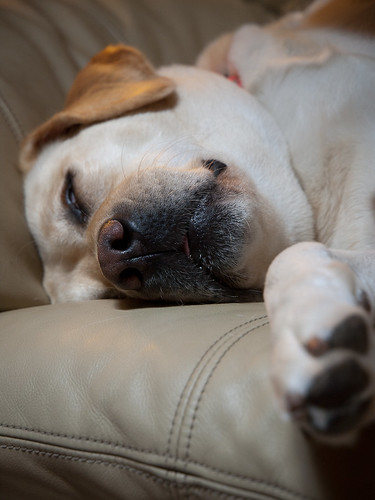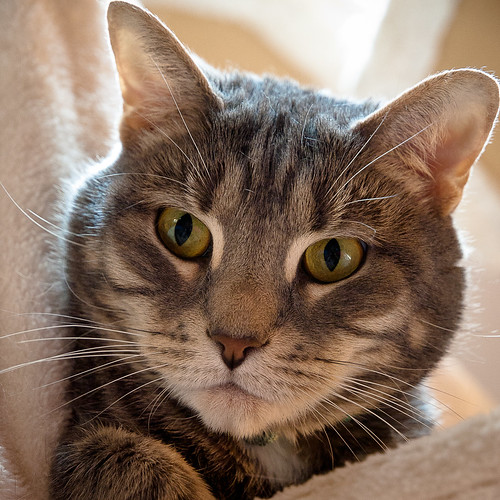Don't Fear the ISO
Spend enough times in the forums listening to the crowds and you come away with two conflicting Photographic Truths;
Second, high ISO, which is usually close to the maximum ISO of the bodies, increases noise dramatically and decreases dynamic range. All digital cameras work this way. Selecting ISO values higher than base increases the light amplification factor of the sensor and internal image processor. You select higher ISOs because the scene is dimly lit, and you want to use a reasonable lens aperture and shutter speed, especially for hand-held photography. Greater amplification means greater noise in the final image.
Again, there is some truth to the claims against Olympus, especially at high ISO values starting at 3200 and higher. ISO 3200 is the maximum ISO for both the E-1 and the E-3, and at those apertures you get a tremendous amount of noise, banding, and other artifacts from the struggle to capture a decent photograph at those very low light levels.
But the truth, as always, is nuanced. For example, not everybody has to shoot at ISO 3200 and higher. If you do, then there's very few choices, and they come from Canon and Nikon and cost thousands of dollars more than any Olympus camera. At high ISOs ranging from 800 to 2000, however, the E-1, and especially the E-3, can produce quite reasonable, of not excellent, results.
Both images below of Ruby and Lulu were taken at high ISO as indicated on each photo. They were taken inside the house, in darker corners of the living room. The larger body of the E-3 provided dampening of shake, and in-body image stabilization was enabled. Thus, the higher ISO combined with IBIS helped to capture these images with minimal motion blurring (if any).
What I have noticed recently is that the latest versions of Lightroom 3 (these were processed with LR 3.3) do a much better job of converting Olympus RAW into JPEG than do the E-1's and E-3's built-in JPEG engines. And there's nothing wrong with that. The E-1 was released in 2003, and the E-3 in 2007. While the built-in JPEG processing is good, PC-based JPEG engines in top-drawer image applications such as Lightroom will benefit from continuous improvement. So it shouldn't be surprising that at some point post-processing JPEG engines surpass in-camera JPEG engines.
Issues with banding and the peculiar artifacts due to internal camera JPEG processing are minimal or non-existent with Lightroom. Buying up-to-date PC-based post-processing software to take advantage of these advances can make the output of older camera gear look much better than what it seemingly was capable of when it was first released, and is a much cheaper alternative to replacing existing camera gear, if all you're primarily after is better image quality.
- Only Base ISO should be used. Using high ISO is a sin; and
- Any camera brand other than Olympus handles high ISO.
Second, high ISO, which is usually close to the maximum ISO of the bodies, increases noise dramatically and decreases dynamic range. All digital cameras work this way. Selecting ISO values higher than base increases the light amplification factor of the sensor and internal image processor. You select higher ISOs because the scene is dimly lit, and you want to use a reasonable lens aperture and shutter speed, especially for hand-held photography. Greater amplification means greater noise in the final image.
Again, there is some truth to the claims against Olympus, especially at high ISO values starting at 3200 and higher. ISO 3200 is the maximum ISO for both the E-1 and the E-3, and at those apertures you get a tremendous amount of noise, banding, and other artifacts from the struggle to capture a decent photograph at those very low light levels.
But the truth, as always, is nuanced. For example, not everybody has to shoot at ISO 3200 and higher. If you do, then there's very few choices, and they come from Canon and Nikon and cost thousands of dollars more than any Olympus camera. At high ISOs ranging from 800 to 2000, however, the E-1, and especially the E-3, can produce quite reasonable, of not excellent, results.
Both images below of Ruby and Lulu were taken at high ISO as indicated on each photo. They were taken inside the house, in darker corners of the living room. The larger body of the E-3 provided dampening of shake, and in-body image stabilization was enabled. Thus, the higher ISO combined with IBIS helped to capture these images with minimal motion blurring (if any).
 |
| Ruby Olympus E-3, Zuiko 12-60mm, ISO 800, f/4, 1/25s |
 |
| Lulu Olympus E-3, Zuiko 12-60mm, ISO 1600, f/4, 1/13s |
What I have noticed recently is that the latest versions of Lightroom 3 (these were processed with LR 3.3) do a much better job of converting Olympus RAW into JPEG than do the E-1's and E-3's built-in JPEG engines. And there's nothing wrong with that. The E-1 was released in 2003, and the E-3 in 2007. While the built-in JPEG processing is good, PC-based JPEG engines in top-drawer image applications such as Lightroom will benefit from continuous improvement. So it shouldn't be surprising that at some point post-processing JPEG engines surpass in-camera JPEG engines.
Issues with banding and the peculiar artifacts due to internal camera JPEG processing are minimal or non-existent with Lightroom. Buying up-to-date PC-based post-processing software to take advantage of these advances can make the output of older camera gear look much better than what it seemingly was capable of when it was first released, and is a much cheaper alternative to replacing existing camera gear, if all you're primarily after is better image quality.

Comments
Post a Comment
All comments are checked. Comment SPAM will be blocked and deleted.